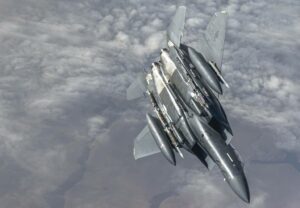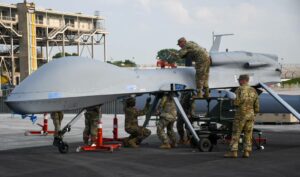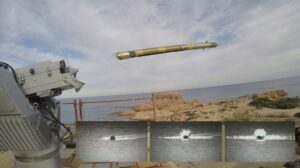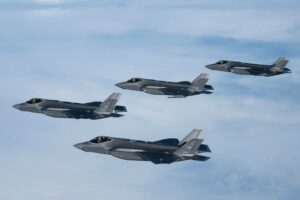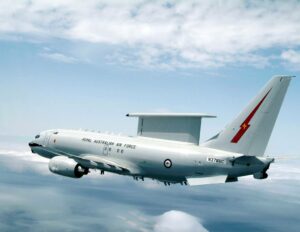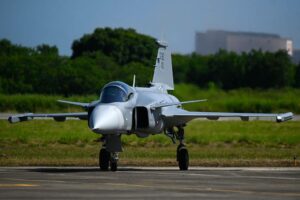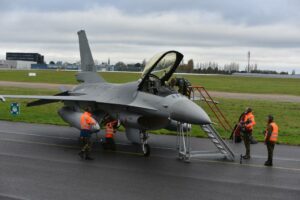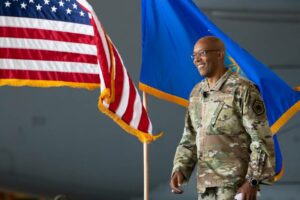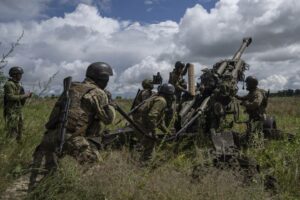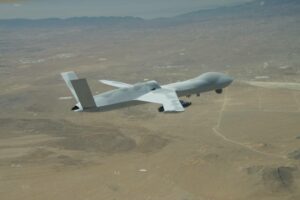WASHINGTON — Bombs boom. Tanks trundle. Fighters fly. All are visible to the human eye and are familiar images of war.
But invisible battles are fought, too. And as the U.S. prepares for potential conflict with China in the Indo-Pacific or with Russia in Europe, the value of the electromagnetic spectrum is proving paramount. Militaries rely on the unseen energy to communicate, guide weapons, spoof and spy, and more.
The U.S. military in 2021 activated the 350th Spectrum Warfare Wing, a first-of-its-kind entity aimed squarely at spectrum dominance and related electronic warfare equipment. Headquartered at Eglin Air Force Base in Florida, the wing is staffed by engineers and EW specialists, including its commander, Col. Joshua Koslov.
In an interview with C4ISRNET, Koslov discussed the importance of his wing; its ties to the Pentagon’s connect-everything campaign known as Joint All-Domain Command and Control, or JADC2; and concerns expressed by at least one Air Force senior leader that the U.S. is losing its EW “muscle memory.”
The conversation below was edited for length and clarity.
What makes the 350th Spectrum Warfare Wing special? Why was this wing necessary?
There wasn’t a commander who was focused on Air Force electronic warfare types of activities. So they needed to put all that into one place, where we can develop the tactics, the techniques, the procedures, the thought processes and deliberately develop the people to be able to inform war plans and budgets in order to make sure that we gain the advantage that we need to in the spectrum. And that’s what the 350th Spectrum Warfare Wing’s job is.
We have three primary missions. What we do is rapidly reprogram. We do target waveform development, and then we do assessment. What that is, is really a circle of the things we have to be able to do in the spectrum.
The adversary is going to react to what we’re doing, we have to be able to reprogram our systems quickly based on that reaction, and we have to develop new capability in order to attack new systems that come online from our adversaries, and then we have to be able to understand, from a readiness perspective, from tooth to tail, on data production, data reception to data transmission, how good are we in the spectrum.
That’s the focus of this wing, and that’s what’s going to make us win if we have to fight a peer competitor.
EW has been thought of as a supporting effort, not necessarily something that leads the way. Is that still accurate, or how has the thinking changed?
That’s a really good question, and it’s at the root of why we exist as a wing.
What has changed is the importance of the spectrum environment. When we were fighting in the global war on terror, we were fighting against an enemy that really couldn’t reach out and touch us. And so things got easier. And the way we use the spectrum was a different way than we need to against a near-peer, when we’re breaking down the door of integrated air defense systems, and like systems, that have the opportunity to or the ability to kill our forces.
So we realized we had a deficit, and we created the electromagnetic superiority strategy and identified a lot of tasks that the Air Force and the Department of Defense, writ large, had to accomplish in order to regain complete advantage in the spectrum. Part of that is an understanding that our systems and our adversary systems rely heavily on the spectrum.
This wing is a little unique in a sense that we focus on the Air Force, but I am a joint and coalition wing, and the spectrum itself is inherently coalition, inherently joint. It’s a common. And our adversaries are building weapons systems that rely on it, just like we are.
If you can dominate and control it — whether totally or in pockets of excellence — you’re going to win engagements and battles and wars.
So I think the way that I talk about it all the time is that where we need to go with the spectrum is: We can use EW to achieve the joint force commander’s objectives across the scale of conflict, from competition to high-end conflict.
How have you and your team folded EW into Air Force and joint exercises recently? What does that actually look like?
EW, from a platform perspective, has always been part of our training exercises. However, what we’ve done recently is we have amplified the amount of rapid reprogramming and data transfer in our exercises. I’ve attempted to have our blue forces pay a penalty — a stiff penalty — for not responding correctly.
I view this wing as an operational warfighting wing; our weapon is going to be data, EW data. And we’re integrating that now.
A challenge for that is that it’s very hard, in the EW world where things are highly classified, to really wring out all of the tactics, techniques and procedures. So we’re also really influencing the development of a virtual environment that fully encompasses the way we can train and operate in the spectrum.
What makes training effective is being able to assess and debrief at the end of the day. What makes that transition from your question about ‘EW sort of being in the background and you can’t see it’ is the ability to assess and then, in debrief, provide tactics that are accessible and understood by the team, in order to build that confidence, so that you can prove to the joint force commander that you can meet his objectives with using electronic warfare capabilities.
Air Force Gen. CQ Brown told Congress recently the U.S. was losing its EW muscle memory, which could leave troops vulnerable. Do you agree with that assessment, and what can be done to rebuild those muscles?
I absolutely agree with that, because that’s why this wing exists, to rebuild that muscle memory. That’s our charge. It’s, for the United States Air Force through the United States Air Force Warfare Center, to raise our EW game across the force.
We do that in a very focused effort based on our pacing challenge campaign plan. We do that through developing training, tactics and assessment procedures that increase the readiness of the force.
I think where we have to focus is on the highest-end or most difficult problems, because I believe in the lesser-included threat, which means if I could do it at the highest end, I should be able to adapt to lower-end threats.
Is there any electromagnetic spectrum-related tech you see China or Russia or any other competitor or adversary developing that is particularly troubling to U.S. interests?
Russia and China — China specifically — have invested very significantly in EW capabilities and other capabilities, like intelligence, surveillance and reconnaissance and cyber, in places where they think they can find our soft underbelly of weakness.
Everyone has recognized that the future of warfighting is about data, is about the spectrum. So we’re all rushing toward the same objective of being able to fight and win in the spectrum.
RELATED
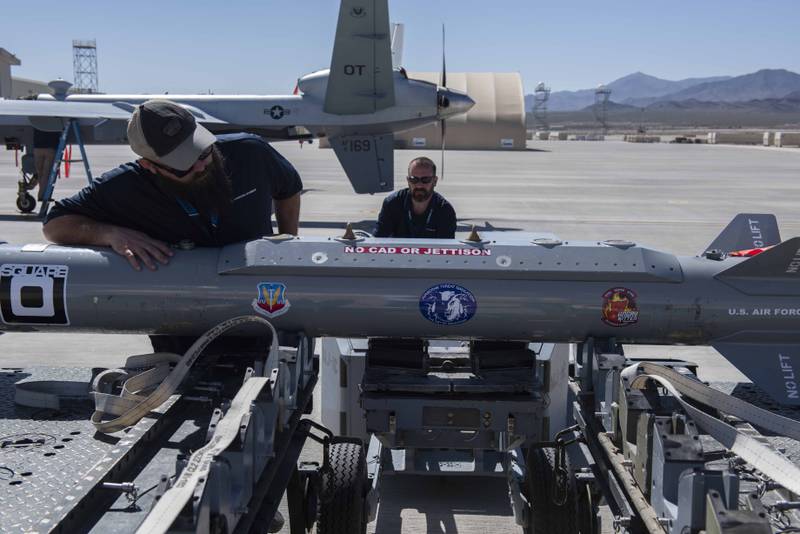
Each of them, our adversaries, have approached the problem a little bit differently. But they’re definitely raising their game. Where I would assess the places where we need to continue to focus is on our attack capability and on our ability to rapidly change in the environment.
We are in this era of JADC2. How do you see protection of those critical networks proceeding? How can the Air Force or EW operations help foster that widespread connectivity the Pentagon wants?
First off, defense is critical, right? My flippant answer to you is the best defense is a good offense, and we’ve got to get better on offense, and we’ve got to get better at closing kill chains faster. That’s No. 1.
The second part of that is: I have five things that are super critical to the success of this wing. And they’re those foundational things that I talked about earlier.
The first one of those is crowdsourced flight data. What that is, is prioritizing the assets that have the best data collected off our adversary systems and getting them into one place so then I can manipulate that data and create new capability against that data.
In order to do that, it requires a data architecture, multi-classification that’s capable of doing that and housing that data and allowing access to the folks that need it. Then the most important part of that is what we affectionately call electromagnetic battle management, as part of the Air Force’s Advanced Battle Management System.
I need to be able to communicate that data off those prioritized jets to the reprogramming centers and the capability builders and then be able to communicate that back out to the warfighters before their next combat sortie. What will make that easier is a fully realized ABMS and making sure that EW requirements are integrated into the Air Force’s ABMS and the joint force’s JADC2 architecture.
One of the ways that we’ll be able to do that faster is a buzzword. It’s cognitive EW.
There are folks out there that will talk about cognitive EW as it’s out at the edge of combat, and it’s making its own decisions and jamming things and that kind of stuff. That future will happen. I think it’s probably 10 to 15 years away to happen at the scale that we talk about sometimes in articles and stuff.
But really what I’m talking about is once you have all that data pulled up, and you’ve communicated it using electromagnetic battle management — the algorithms to scroll through terabytes of data quickly, to identify the critical things that we need to work on, and then be able to get that information back out to the edge as quickly as possible.
The final piece, the fifth thing, is being able to assess that tooth-to-tail process, both for speed and accuracy, in order to be able to codify risk for joint force commanders when they’re trusting us to meet their objectives.
Colin Demarest is a reporter at C4ISRNET, where he covers military networks, cyber and IT. Colin previously covered the Department of Energy and its National Nuclear Security Administration — namely Cold War cleanup and nuclear weapons development — for a daily newspaper in South Carolina. Colin is also an award-winning photographer.
- SEO Powered Content & PR Distribution. Get Amplified Today.
- PlatoData.Network Vertical Generative Ai. Empower Yourself. Access Here.
- PlatoAiStream. Web3 Intelligence. Knowledge Amplified. Access Here.
- PlatoESG. Automotive / EVs, Carbon, CleanTech, Energy, Environment, Solar, Waste Management. Access Here.
- BlockOffsets. Modernizing Environmental Offset Ownership. Access Here.
- Source: https://www.defensenews.com/electronic-warfare/2023/08/02/us-air-force-electronic-warfare-commander-seeks-spectrum-dominance/
- :has
- :is
- :not
- :where
- $UP
- 1
- 10
- 11
- 15 years
- 15%
- 2021
- 2023
- 3000
- 70
- 9
- a
- ability
- Able
- About
- about IT
- absolutely
- access
- accessible
- accomplish
- accuracy
- accurate
- Achieve
- across
- activated
- activities
- actually
- adapt
- administration
- advanced
- ADvantage
- against
- aimed
- aims
- AIR
- Air Force
- algorithms
- All
- also
- always
- am
- amount
- Amplified
- an
- and
- answer
- any
- April
- architecture
- ARE
- articles
- AS
- assess
- assessment
- Assets
- At
- attack
- attempted
- award-winning
- away
- back
- background
- base
- based
- Battle
- battles
- BE
- because
- been
- before
- being
- believe
- below
- BEST
- Better
- Bit
- Blue
- boom
- both
- Breaking
- Budgets
- build
- builders
- Building
- but
- buzzword
- by
- call
- Campaign
- CAN
- capabilities
- capability
- capable
- Carolina
- Center
- Centers
- chains
- challenge
- change
- changed
- charge
- China
- Circle
- clarity
- classified
- closing
- cognitive
- cold
- combat
- come
- Common
- communicate
- communicated
- competition
- competitor
- complete
- Completed
- concept
- Concerns
- confidence
- conflict
- Congress
- Connect
- Connectivity
- continue
- control
- Conversation
- could
- covered
- covers
- create
- created
- critical
- cyber
- daily
- data
- day
- Debrief
- decisions
- Defense
- DEFICIT
- definitely
- Department
- department of defense
- Department of Energy
- develop
- developing
- Development
- different
- difficult
- discussed
- do
- does
- doing
- Dominance
- dominate
- done
- Door
- down
- Earlier
- easier
- Edge
- Effective
- effort
- Electronic
- encompasses
- end
- energy
- engagements
- Engineers
- entity
- Environment
- equipment
- Era
- Ether (ETH)
- Europe
- evaluation
- Excellence
- exist
- exists
- expressed
- eye
- false
- familiar
- faster
- fifth
- fight
- fighters
- fighting
- final
- Find
- First
- five
- flight
- florida
- Focus
- focused
- For
- Force
- Forces
- Foster
- from
- fully
- future
- Gain
- game
- Gen
- get
- getting
- Global
- Go
- going
- good
- Ground
- guide
- had
- happen
- Hard
- Have
- he
- headquartered
- heavily
- help
- High-End
- highest
- highly
- his
- housing
- How
- However
- http
- HTTPS
- human
- i
- identified
- identify
- if
- image
- images
- importance
- important
- in
- Including
- influencing
- inform
- information
- inherently
- integrated
- Integrating
- Intelligence
- interests
- Interview
- into
- invested
- IT
- ITS
- itself
- Jets
- Job
- joint
- jpg
- just
- Kill
- Kind
- King
- known
- large
- leader
- Leads
- least
- Leave
- Length
- like
- little
- Look
- look like
- losing
- Lot
- make
- MAKES
- Making
- management
- management system
- means
- Meet
- Memory
- militaries
- Military
- missions
- more
- most
- my
- namely
- National
- necessarily
- necessary
- Need
- needed
- networks
- NEVADA
- New
- next
- no
- now
- nuclear
- Nuclear weapons
- objective
- objectives
- of
- off
- on
- once
- ONE
- online
- operate
- operational
- Operations
- Opportunity
- or
- order
- Other
- our
- out
- own
- Paramount
- part
- particularly
- Pay
- peer
- pentagon
- People
- perspective
- photo
- photographer
- piece
- Place
- Places
- plan
- plans
- platform
- plato
- Plato Data Intelligence
- PlatoData
- pockets
- possible
- potential
- Prepares
- previously
- primary
- prioritized
- prioritizing
- probably
- Problem
- problems
- procedures
- process
- processes
- Production
- protection
- Prove
- provide
- put
- question
- quickly
- raise
- raising
- rapid
- rapidly
- reach
- React
- reaction
- Readiness
- realized
- really
- recently
- reception
- recognized
- regain
- related
- rely
- reporter
- Requirements
- requires
- responding
- right
- Risk
- root
- round
- Russia
- s
- same
- Scale
- Screen
- Second
- security
- see
- Seeks
- senior
- sense
- sensors
- should
- significantly
- So
- Soft
- something
- South
- South carolina
- special
- specialists
- Spectrum
- speed
- States
- Still
- Strategy
- success
- Super
- Supporting
- sure
- surveillance
- system
- Systems
- tactics
- Talk
- talking
- Tanks
- Target
- tasks
- team
- tech
- techniques
- Technologies
- test
- Testing
- than
- that
- The
- The Future
- the joint
- their
- Them
- then
- There.
- they
- thing
- things
- think
- Thinking
- this
- those
- thought
- threat
- threats
- three
- Through
- Ties
- time
- to
- too
- TOTALLY
- touch
- toward
- Train
- Training
- transfer
- transition
- troubling
- trusting
- types
- u.s.
- understand
- understanding
- understood
- unique
- United
- United States
- us
- use
- using
- value
- Vast
- very
- View
- Virtual
- visible
- visualization
- Vulnerable
- wants
- war
- was
- Way..
- ways
- we
- weakness
- Weapons
- were
- What
- when
- whether
- which
- WHO
- why
- widespread
- will
- win
- Wing
- with
- Work
- world
- would
- years
- you
- Your
- zephyrnet

